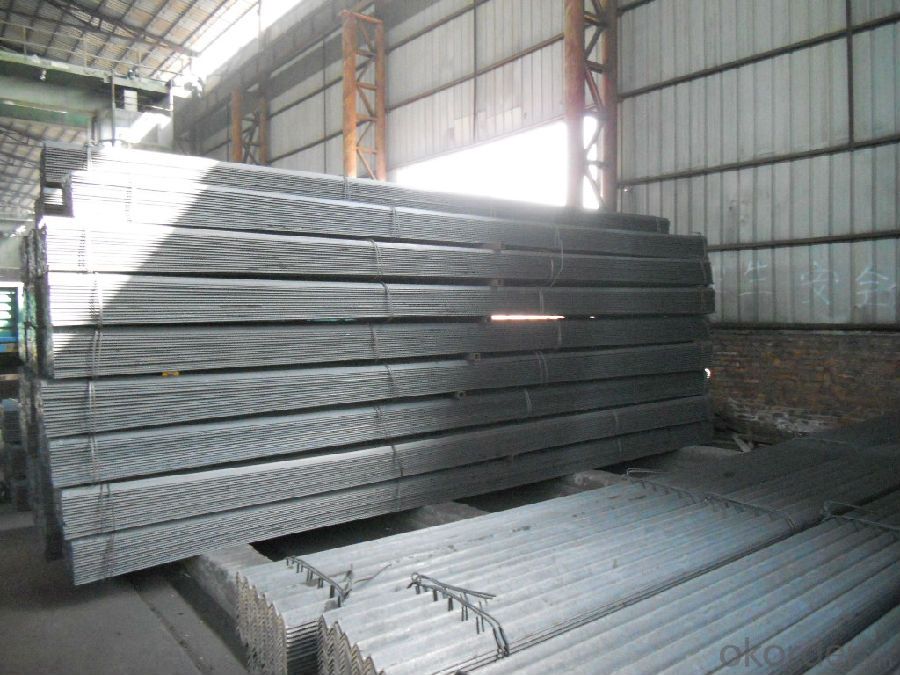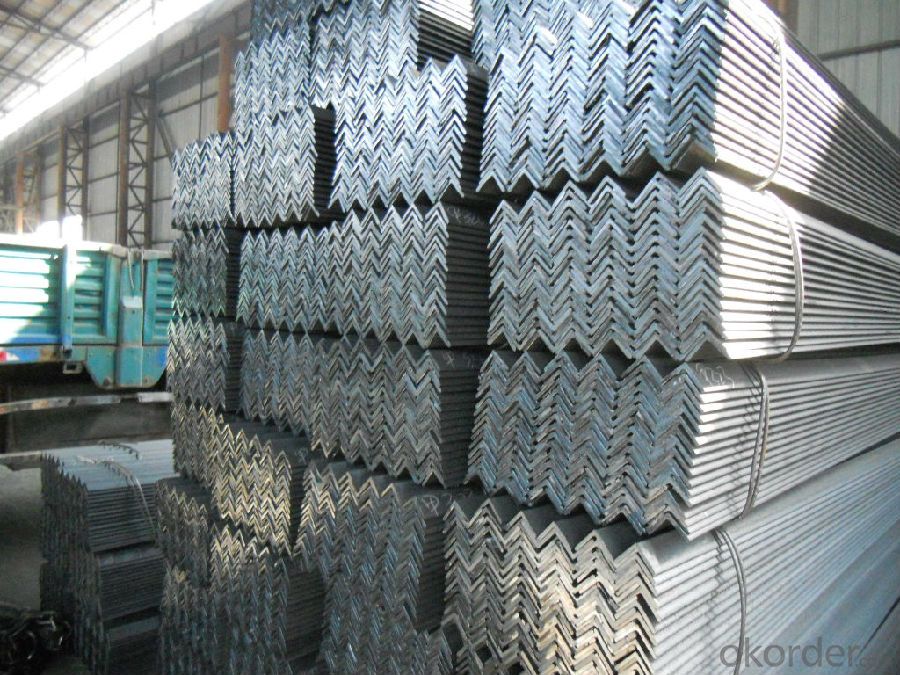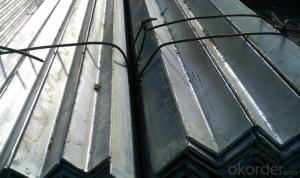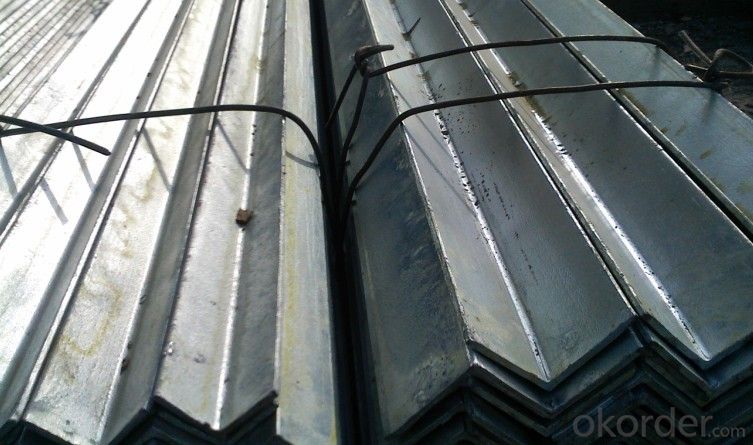Hot Rolled Steel Equal Angles Q235, A36, SS400, 235JR for Construction
- Loading Port:
- China main port
- Payment Terms:
- TT or LC
- Min Order Qty:
- 25000 m.t.
- Supply Capability:
- 200000 m.t./month
OKorder Service Pledge
OKorder Financial Service
You Might Also Like
Specifications of Hot Rolled Steel Equal Angles Q235, A36, SS400, 235JR for Construction:
1. Standards: GB,ASTM,BS,AISI,DIN,JIS
2. Length:6m,9m,12m
3. Material:Material: GB Q235B, Q345B or Equivalent; ASTM A36; EN 10025, S235JR, S355JR; JIS G3192, SS400;
SS540.
4. Sizes:
Sizes: 25mm-250mm | ||
a*t | ||
25*2.5-4.0 | 70*6.0-9.0 | 130*9.0-15 |
30*2.5-6.6 | 75*6.0-9.0 | 140*10-14 |
36*3.0-5.0 | 80*5.0-10 | 150*10-20 |
38*2.3-6.0 | 90*7.0-10 | 160*10-16 |
40*3.0-5.0 | 100*6.0-12 | 175*12-15 |
45*4.0-6.0 | 110*8.0-10 | 180*12-18 |
50*4.0-6.0 | 120*6.0-15 | 200*14-25 |
60*4.0-8.0 | 125*8.0-14 | 250*25 |
5. Chemical data: %
C | Mn | S | P | Si |
0.14-0.22 | 0.30-0.65 | ≤0.050 | ≤0.045 | ≤0.30 |
Usage & Applications of Hot Rolled Steel Equal Angles Q235, A36, SS400, 235JR for Construction:
Trusses;
Transmission towers;
Telecommunication towers;
Bracing for general structures;
Stiffeners in structural use.
Packaging & Delivery of Hot Rolled Steel Equal Angles Q235, A36, SS400, 235JR for Construction:
1. Transportation: the goods are delivered by truck from mill to loading port, the maximum quantity can be loaded is around 40MTs by each truck. If the order quantity cannot reach the full truck loaded, the transportation cost per ton will be little higher than full load.
2. With bundles and load in 20 feet/40 feet container, or by bulk cargo, also we could do as customer's request.
3. Marks:
Color mark: There will be color marking on both end of the bundle for the cargo delivered by bulk vessel. That makes it easily to distinguish at the destination port.
Tag mark: There will be tag mark tied up on the bundles. The information usually including supplier logo and name, product name, made in China, shipping marks and other information request by the customer.
If loading by container the marking is not needed, but we will prepare it as customer request.
FAQ:
Q1: How do we guarantee the quality of our products?
A1: We have established an advanced quality management system which conducts strict quality tests at every step, from raw materials to the final product. At the same time, we provide extensive follow-up service assurances as required.
Q2: How soon can we receive the product after purchase?
A2: Within three days of placing an order, we will begin production. The specific shipping date is dependent upon international and government factors, but is typically 7 to 10 workdays.
Q3: What makes stainless steel stainless?
A3: Stainless steel must contain at least 10.5 % chromium. It is this element that reacts with the oxygen in the air to form a complex chrome-oxide surface layer that is invisible but strong enough to prevent further oxygen from "staining" (rusting) the surface. Higher levels of chromium and the addition of other alloying elements such as nickel and molybdenum enhance this surface layer and improve the corrosion resistance of the stainless material.
Images:


- Q: Can steel angles be galvanized or coated for additional protection?
- Yes, steel angles can be galvanized or coated for additional protection. Galvanizing or coating provides a protective layer that helps prevent corrosion and extends the lifespan of the steel angle.
- Q: Can steel angles be recycled?
- Yes, steel angles can be recycled. Steel is one of the most recycled materials in the world, and steel angles are no exception. When steel angles are no longer needed or reach the end of their lifecycle, they can be collected, processed, and turned into new steel products. Recycling steel angles helps to conserve natural resources, reduce energy consumption, and minimize waste. This makes steel angles a sustainable and environmentally friendly choice for construction and other applications.
- Q: Can steel angles be used for staircases or handrails?
- Yes, steel angles can be used for staircases and handrails. Steel angles are versatile and commonly used in construction for their strength and durability. In staircases, steel angles can be used as stringers, providing support for the steps and ensuring stability. They can also be used as handrails, offering a sturdy grip and support for individuals using the staircase. Steel angles can be welded or bolted into place, making them an excellent choice for staircases and handrails that require secure and long-lasting installations. Additionally, steel angles can be customized to fit specific design requirements, allowing for flexibility in creating aesthetically pleasing and functional staircases and handrails.
- Q: What are the different types of connections used for steel angles in structural applications?
- Steel angles in structural applications can be connected using various types of connections. These connections play a crucial role in maintaining the stability and strength of the overall structure. Firstly, welded connections are commonly used. This method involves fusing the edges of the steel angles together through melting, resulting in a strong bond. Welded connections are ideal for applications that require high strength and rigidity. Secondly, bolted connections provide flexibility as they involve using bolts and nuts to secure the steel angles. This type of connection allows for easy disassembly and reassembly if needed. Bolted connections are often chosen for their ease of installation and maintenance. Thirdly, riveted connections are a traditional method of joining steel angles. This involves inserting a rivet through holes in the steel angles and flaring the ends to secure them. Although riveted connections are known for their durability and resistance to corrosion, they are less commonly used today due to the time-consuming installation process. Next, clip connections utilize metal clips or brackets to attach the steel angles quickly and efficiently. These clips can be welded or bolted to the angles, making them suitable for applications where speed and ease of installation are important. Lastly, gusset plate connections involve using steel plates to connect the steel angles at their intersection points. These plates are typically welded or bolted to the angles, enhancing the strength and stability of the connection. Gusset plate connections are often employed when larger forces and moments need to be transferred. It is essential to consider the specific needs of the structure, including the structural requirements, loadings, and the intended application, when choosing the appropriate connection method. Adhering to design and engineering specifications ensures that the selected connection method is suitable for the desired use in structural applications.
- Q: Can steel angles be used for retaining walls?
- Yes, steel angles can be used for retaining walls. Steel angles are commonly used in construction for various purposes, including supporting structures and creating retaining walls. They provide strength and stability to the wall, making them suitable for retaining soil or other materials. Steel angles can be used as a primary structural element or in combination with other materials, such as concrete or timber, to form a robust and durable retaining wall. The specific design and engineering considerations would depend on factors such as the height and load requirements of the wall, as well as the soil conditions and local building codes. However, with proper design and installation, steel angles can be an effective choice for retaining walls.
- Q: Can steel angles be used in conveyor belt supports?
- Yes, steel angles can be used in conveyor belt supports. Steel angles are commonly used as structural supports in various applications due to their strength and durability. They provide excellent load-bearing capacity and can withstand heavy weights, making them suitable for supporting conveyor belts. The angles can be used to create a sturdy framework or structure that holds the conveyor belt in place and allows it to move smoothly. Additionally, steel angles can be easily fastened or welded together, providing a secure and stable support system for conveyor belts.
- Q: Can steel angles be used as lintels or supports for openings?
- Yes, steel angles can be used as lintels or supports for openings. Steel angles are commonly used in construction to distribute the load from above openings such as windows and doors, providing structural support and stability. They are strong, durable, and can be easily customized to fit the required dimensions, making them a suitable choice for lintels or supports in various construction projects.
- Q: How do steel angles perform in corrosive gas or liquid environments?
- Steel angles perform well in corrosive gas or liquid environments, thanks to their high resistance to corrosion. The protective oxide layer that forms on the surface of steel angles helps prevent the steel from being directly exposed to the corrosive elements, ensuring its durability and longevity in such environments.
- Q: What are the different types of steel angles connections?
- Construction and engineering projects utilize various steel angle connections. Some commonly used types are: 1. Welded Connection: Skilled welders join the angles using welding techniques, creating a robust and rigid connection. However, this method requires time and expertise. 2. Bolted Connection: Bolts, nuts, and washers connect the angles, allowing for easy disassembly and modification. It is popular for temporary structures or situations requiring future changes. Additional reinforcement like gussets or plates can be used. 3. Riveted Connection: In older steel structures and bridges, riveting was commonly employed. Rivets, which are metal pins with a head, are hammered into pre-drilled holes to form a permanent connection. 4. Clip Angle Connection: Clip angles, small steel angles, are bolted or welded to the main angles, providing additional support and reinforcement. This enhances the strength and stability of the primary connection. 5. Pinned Connection: Pinned connections enable rotational movement between angles, allowing for flexibility and load redistribution. A pin or bolt passes through holes in the angles, enabling free rotation. 6. Gusset Plate Connection: Gusset plates, flat steel plates, connect and reinforce the angles. They are typically bolted or welded to the angles, adding strength and stability to the connection. The selection of a steel angle connection depends on factors such as load-bearing requirements, structural design, installation ease, and future modifications. Each type has its own advantages and disadvantages, and engineers carefully choose the most suitable connection based on project-specific needs.
- Q: What is the minimum radius for a curved steel angle?
- The minimum radius for a curved steel angle will vary depending on the specific application and the capabilities of the steel fabrication processes being used. However, in general, the minimum radius for a curved steel angle is typically determined by the thickness and type of steel being used, as well as any applicable industry standards or regulations. It is important to consult with a structural engineer or steel fabricator to determine the appropriate minimum radius for a specific curved steel angle.
Send your message to us
Hot Rolled Steel Equal Angles Q235, A36, SS400, 235JR for Construction
- Loading Port:
- China main port
- Payment Terms:
- TT or LC
- Min Order Qty:
- 25000 m.t.
- Supply Capability:
- 200000 m.t./month
OKorder Service Pledge
OKorder Financial Service
Similar products
Hot products
Hot Searches
Related keywords




























